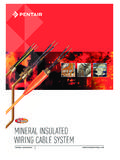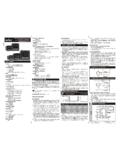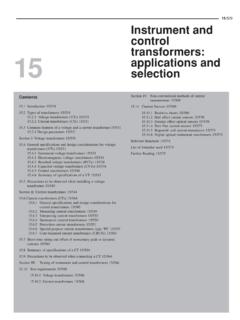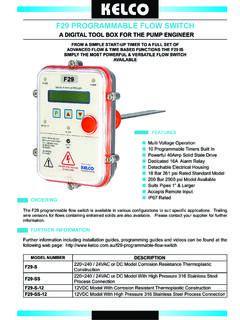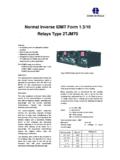Transcription of Linear Heat Detection Specification Document 20 …
1 Linear Heat Detection _____ Systems Specification _____ GUIDE LINES FOR THE INSTALLATION OF FIRESENSE 2000 Linear HEAT Detection CABLE. IMPORTANT NOTE: Before installing FIRESENSE 2000 Linear Heat Detection Cable reference should be made to the zone layout drawings, fixing arrangement drawings and the following points should be observed: The cable should not be in contact with any material that will act as a heat sink and delay the sensing of temperature increase in the area being protected. The FIRESENSE 2000 End of line unit (part no. 100637) and Junction boxes (part no. 100012) should be employed as these are supplied with the correct type and size of cable gland.. FIRESENSE 2000 Linear Heat Detection Cable should be installed so that it is not severely compressed and is not adjacent to sharp objects that may damage the outer sheath.
2 The minimum bend radius of 6mm should be adhered to carefully. Cable ties should not be use directly on the cable a neoprene sleeve should always be employed (part no. 500020). These and other proprietary fixings are available from Tyco Fire & Integrated Solutions. Whilst FIRESENSE 2000 Linear Heat Detection Cable has a high tensile strength care should be taken not to place it under too much tension especially where there is a change of direction at a fixing. The distance between fixings should be between and dependent upon fixing positions available. The routing of FIRESENSE 2000 Linear Heat Detection Cable should be chosen to avoid any local sources of heat such as light fittings, steam pipes etc.
3 The minimum number of joints should be made in any run of FIRESENSE 2000 Linear Heat Detection Cable and any joint should always be made in the FIRESENSE junction box (part no. 100012) available from Tyco Fire & Integrated Solutions. Adjacent zones should overlap by a minimum of 50mm. All interposing cable between FIRESENSE 2000 Linear Heat Detection Cable and its controller should have an integral metallic screen/braid/sheath/armour as part of its construction and this should be connected to earth to improve RFI and EMI immunity. The connections should be made using a FIRESENSE 2000 interposing junction box (available from Tyco Fire & Integrated Solutions). For further details see interposing Cables in the next section of this manual.
4 Where a number of zones of FIRESENSE 2000 Linear Heat Detection Cable are remote from their controllers a multi-core cable should not be used for interconnections. Individual coaxial or screened pair cables should be used which meet the criteria above. SPECIAL GUIDE LINES FOR CABLE WAY PROTECTION IMPORTANT NOTE: In addition to the above recommendations 1-12, the following should be observed: FIRESENSE 2000 Linear Heat Detection Cable should be installed to cover each cable tray or ladder rack intended for supporting cables. Generally one run of sensing cable should be installed centrally above each tray or ladder rack with a further two runs of cable below the bottom level. (one on the outer edge and one on the support edge).
5 On horizontal cable routes where cables are mounted vertically the FIRESENSE 2000 Linear Heat Detection Cable should be routed level with the top edge of the support system on the cable side. On lengths of vertical racking less than 1m, used for carrying cables between horizontals, FIRESENSE 2000 Linear Heat Detection Cable should be located across the top of the rising group of cables. Where the riser does not start at floor level a loop of FIRESENSE 2000 Linear Heat Detection Cable should be provided at the top and bottom of the rising group of cables. In case of flumes and risers FIRESENSE 2000 Linear Heat Detection Cable should be run across the top of the rising group of cables and diagonally from side to side across the support system on the vertical sections.
6 The distance between supports should be between and FIRESENSE 2000 Linear Heat Detection Cable should be installed such that it can rapidly respond to convected and/or radiated heat from any event. In general it should be between 150 and 250mm above the cables that are being protected. Where there are many levels of cable support and there is tray or ladder racking that is over twice the width of the cable below, the wider level should be provided with a run of FIRESENSE 2000 Linear Heat Detection Cable below the overhanging edge. This should be in addition to the run protecting the level immediately below. SPECIAL GUIDE LINES FOR SPACE PROTECTION ON CEILINGS FIRESENSE 2000 Linear Heat Detection Cables should in general be spaced on the ceiling above the area to be monitored such that the cable is between and from any zone boundary, wall or beam having a depth greater than 10% of the ceiling height.
7 The distance between adjacent runs should be no more than 7m. In Plan view no point should be more than perpendicular to the sensing cable. (As specified in BS 5839 Part1 1998) The sensing cable should not traverse other zones to reach control equipment or end of line units; a fire resisting cable should be used for interconnection together with an interposing junction box. (part number 100012) FIRESENSE 2000 Linear Heat Detection Cable should be installed such that it is between 25 and 150mm from the ceiling. IMPORTANT NOTE: The above are general recommendations for guidance only. There may be conditions at site or clients requirements where some of the above criteria needs to be varied. As well as providing cover as detailed above, additional runs of cable may be employed directly over specific risks.
8 I NTERPOSING CABLES FOR FIRESENSE 2000 INTERCONNECTIONS In many installations it may be necessary to mount the FIRESENSE 2000 controller remotely from the zone where the FIRESENSE 2000 Linear Heat Detection Cable is installed. It is also possible to have separate lengths of FIRESENSE 2000 Linear Heat Detection Cable covering different risks in a zone connected to the same controller. In each of these cases it is necessary for the interposing cable used for these interconnections to meet certain requirements to ensure trouble free installation. FIRESENSE 2000 Linear Heat Detection Cable is of a coaxial construction with an outer screen of tinned copper wire braid. This arrangement ensures the highest possible electrical noise immunity and therefore it is essential that any interposing cables also have some form of screen in their construction.
9 The interposing cable should also have fire resisting qualities and dependant upon the Fire Regulations for the particular site one of the following types of cable may be used: Mineral insulated copper covered (MICC) Copper sheath. Steel wire armoured (SWA) Outer wire armouring. Pirelli FP200 Internal alloy laminate with drain wire. Delta Firetuf Internal aluminium foil with drain wire. In all installations it is important to ensure that there is no reversal of the core and screen connections, as this will greatly increase the susceptibility of the system to electrical noise. As these cables are readily available in 2-core construction, in order to optimise the noise immunity the connections should be made in one of two ways.
10 METHOD 1 Outer sheath/screen bonded to local earth For this method the two cores of the interposing cable are designated for core (C) and screen (S) connection to the FIRESENSE 2000 Linear Heat Detection Cable and the outer sheath/screen is connected to earth at one end. (This arrangement is generally better suited to MICC and SWA installations). METHOD 2 Outer sheath/screen connected to screen connection of the FIRESENSE 2000 control For this method one of the conductors of the interposing cable is designated Screen (S) and the other Core (C). The Core connection is straight forward, however the conductor designated Screen must be connected both to the Screen connection at the Firesense Controller end and to the outer sheath/screen.

